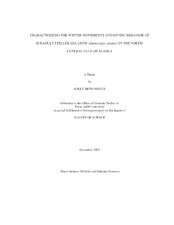| dc.description.abstract | Recent studies indicate a 70% decrease in the Alaskan Steller sea lion (SSL) population
(ca. 5% per year) since the early 1980's. In accordance with a 1997 status classification of the
Western Steller sea lion (WSSL) stock as endangered, the "critical habitat" for the species was to
be defined. This habitat has now been designated to include 10-20 nautical mile buffer zones
around most rookeries and haulouts in the Gulf of Alaska (GOA) and Aleutian Islands. However,
these zones were based on limited, summer, foraging data.
The primary objective of this study was to characterize juvenile SSL diving behavior
and habitat use along the Kenai Peninsula and Prince William Sound (PWS) from winter to
spring. Fifteen free ranging, subadult SSL of both sexes were captured and equipped with
satellite telemeters at five haulout sites in PWS and Resurrection Bay, Alaska. Telemeters
transmitted for an average of 122 days (range 38-181 days). A total of 11,692 locations were
received and 217,419 dives recorded.
All sea lions exhibited localized movements parallel or close to shore (3-15 km
offshore). Young of the year (YOY) exhibited high site fidelity. Older juvenile sea lion lions
were less restricted in their movements and traveled greater distances (200-400km) visiting a
variety of islands, buoys, and other locations in PWS.
Most dives were short (mean duration = 1.1 min) and shallow (mean depth = 10.8 m),
with animals diving to an average maximum depth of 193 m. During winter (January and February), many dives (>40%) occurred during the daytime (0900-1500 LT). However, by April
and May this pattern shifted and the animals made most of their dives (>40%) during the night
(2100-0300 LT). This relationship was more pronounced for dives deeper than 20 m and
coincided with the seasonal increase in photoperiod.
Subadult SSL, especially YOY, remained within the 20 nautical mile coastal zone during
winter and spring. Shallow, nearshore waters provide important habitat during this critical
period of transition to nutritional independence. However, more conclusive data on SSL
foraging ecology is necessary to better understand locations and depths preferred by the species. | en |


